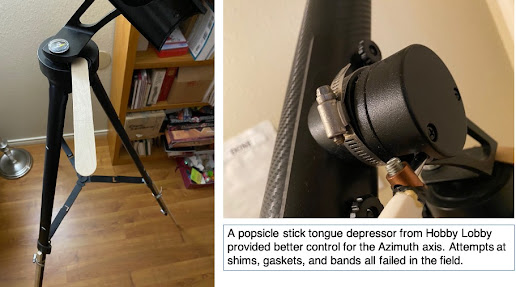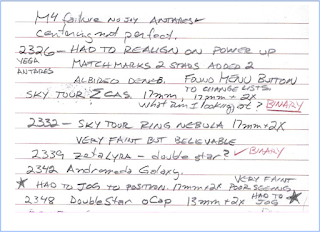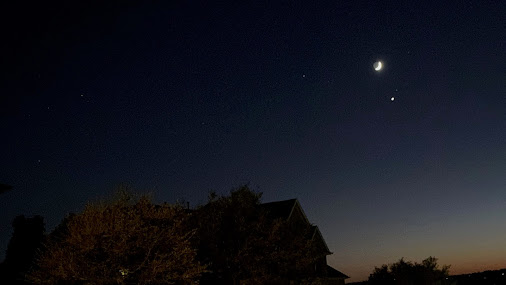In a kerfuffle on the Sky Searchers astronomy discussion board, a couple of the stalwarts insisted contrary to the experiential reports of a newbie that “a good 70-mm refractor” can split the popular double-double star system epsilon Lyrae. I could not with my National Geographic 70 mm. (Previously on Necessary Facts.) So, I decided to find out.
I have two new telescopes on order now from Mile High Optics, a Meade 70 mm StarPro AZ and a Celestron 70 mm AZ AstroMaster. I also ordered a new National Geographic 70 mm refractor from Explore Scientific on the likelihood that mine failed for material reasons apart from design and manufacture. The key word there is “apart” because I took the objective apart and had to try a few times to get it back together right. I am still not confident about that.
The three telescopes that I have coming for testing are all achromatic doublets. The design consists of objective lenses of two different kinds of glass to minimize chromatic aberration caused by the refraction of different wavelengths of light by using two slightly different different media. This is a solution known in the 18th century. Better still would be an apochromatic triplet. I have one, an Astro-Tech 115-mm refractor (reported last October here) but that is not part of this experiment.
My superpower is sleeping on a problem and waking up with the solution. (Sometimes, it takes a couple of days.) When I last viewed epsilon Lyrae with my Natl G 70, I was able to resolve the northeast pair, but not the southwest pair. (See also Viewing epsilon Lyrae here from last year.) The two couples are about the same visual distances, primaries from secondaries, and of about the same magnitudes. If one resolved then the other should have also. Based on that, I might take it apart again and rotate the two objective lenses by 90 degrees.
 |
| Williams Optics, Gran Turismo. $933. OTA only, though with Bahtinov mask for precise focus adjustment |
Anyway, the instruments that I ordered are all modest: under $200 for the Celestron and about $150 for the Meade, and just over $100 for the National Geographic. I did not buy the Svbony at $86 because it seems under-developed based on the reports from my colleague on The Sky Searchers and it is a “fast” scope with a short focal length, which comes with other problems, the touchy focusing being first.
Also, I did not buy the high-end 70-mm refractors because I accept as a matter of faith (for lack of a better word) that for the money, the optics would be good, and at the top of the line, fantastic. If the ones that I get cannot resolve the members of the quadruple system, then they fail the standard of “a good 70-mm refractor.”
 |
| Astro-Tech 70-mm $299 Extremely-low Dispersion (ED) glass considered "near apochromatic." f/6 includes dual-speed focuser. OTA only from Astronomics of Norman, Oklahoma. |
The reason why is that the arithmetic demands that standard. The formula for resolution has several expressions, depending on the chosen units, English versus metric, linear or circular.
 |
| Entry-level 70-mm refractors from Meade and Celestron $159 and $189 respectively. Meade is f/10 F=700 mm. Celestron is f/13 F=900 mm. from Mile High Astronomy, Denver, Colorado. |
- Angular resolution in micrometers = 0.25 times [wavelength in micrometers / aperture in meters] (bringing the orders of magnitude into conformance.)
- Angular resolution in radians = 1.22 times [wavelength in micrometers / aperture in micrometers]
- Angular resolution in arc-seconds = 0.25 * [wavelength in micrometers / aperture in micrometers]
For D=70 mm
Green = 1.9 arc-seconds
Violet = 1.38 arc-seconds
Red = 2.43 arc-seconds
Mean = 1.9 arc-seconds
(A Student’s Guide to the Mathematics of Astronomy by Daniel Fleisch and Julia Kregenow, Cambridge University Press, 2013, 2020.)
Resolution = 5.45 / D inches
Resolution = 1.98 arc-seconds
(Star Ware: The Amateur Astronomer’s Guide to Choosing, Buying, and Using Telescopes and Accessories, 4thEdition, by Philip S. Harringon, John Wiley & Sons, Inc,, 2007, pages 6-9.
Smallest Resolvable Angle = [wavelength nanometers]/ [Diameter in nanometers]
Smallest Resolvable Angle (arc-seconds) = [114/ Diameter in nanometers]
for 70 mm = 1.6 arc-seconds
Observers Handbook 2021, Royal Astronomical Society of Canada, page 49.
The angular separations of the companion stars in epsilon Lyrae are given as 2.35 arc-seconds each or 2.4 and 2.5 arc-seconds respectively. "The component stars of ε1 have magnitudes of 4.7 and 6.2 separated by 2.6 (arc-seconds) ... Main components of ε2 have magnitudes 5.1 and 5.5 separated by 2.3 (arc-seconds) ... " -- /https://en.wikipedia.org/wiki/Epsilon_Lyrae
Therefore, based on the above, any 70-mm refractor ought to be sufficient.
 |
| Svbony "fast" f/6 70-mm refractor. $82.90. Comes with 5X finder scope, diagonal, 20 mm eyepiece, and tripod. Made in Hong Kong, sold worldwide. |
The Airy Disk
Astronomer Royal George Biddle Airy (1801-1892) modeled the visual telescopic image of a star in the course of his investigations of optics. The so-called “Airy disc” or diffraction disc is the small central portion of the false image of a star formed by a telescope at focus. Light not contained in the disc forms neat, concentric diffraction rings, or Fresnel rings surrounding the disc. The size of the star image is proportional to the wavelength of light, and inversely proportional to the aperture of a particular optical system. Thus, the larger the aperture, the smaller the Airy disc in stars of the same color.
This ideal representation has confused some observers, who assume that their optics are flawed when stat images on the Airy model do not appear during routine sessions. … Due to atmospheric turbulence and “local seeing” disturbances in the air in and around the telescope, the model appearance is rarely glimpsed in the field. Typically, one sees an amorphous central discoid surrounded by a series of broken, shifting ring segments. […]
In years of observing, the author has only experienced a handful of occasions when the atmosphere rendered a perfect Airy model visible—all in the wee hours of still, humid, subtropical mid-summer nights of marginal transparency. At times like this, planetary details stand out like the lines on a banknote, and doubles generally seen as barely split seem to have widened to admit an extra measure of black space between their components.” – Care of Astronomical Telescopes and Accessories by M. Barlow Pepin, Patrick Moore’s Practical Astronomy Series, Springer-Velag, London, 2005, page 24.
My goals for this project include keeping the Celestron 70 mm f/13 for its long focal length and deacquisitioning the two National Geographics and the Meade. I am also seeking a new Explore Scientific 102-mm f/9.8 F=1000 mm to replace my current one which is f/6.47 F=660 mm.
PREVIOUSLY ON NECESSARY FACTS
Measuring Your Universe: Alan Hirshfeld's Astronomy Activity Manual
Copernicus on the Revolution of Heavenly Bodies
An Online Class in Astrophysics
























